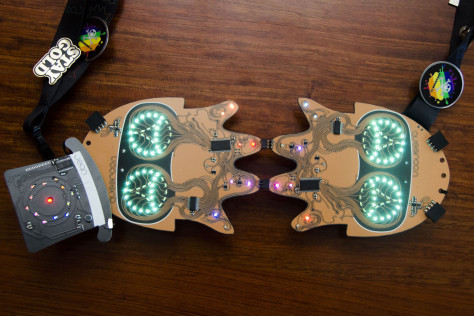THE EARLY DAYS
The original Def Con circuit board badges from 2006. Image: Joe Grand
MADE IN CHINA
The Chameleon badge. Art by @nyaanase and circuit by @dorkengine. Image: Daniel Oberhaus/Motherboard
AND!XOR’s decision to manufacture its badges in the US is rather anomalous in the badgelife community, but it saves the group a lot of headache. Most other badge makers source their custom PCBs from China, which can lead to supply chain issues and almost always seems to result in weeks of delay. For example, many badge makers will order bulk PCB components and then ship them to the PCB manufacturer in China—even though the components themselves are usually made in China.Whitney Merrill, an attorney at Electronic Arts and the founder of Def Con’s Crypto and Privacy Village, knows this all too well. Merrill founded the Crypto and Privacy Village in 2014 and after its initial success she received an email from a fellow hardware hacker Jorge Lacoste, who wanted to discuss the possibility of designing a badge for the Village in time for Def Con 23.“The late nights, last minute scrambles, endless shipping delays from China, the wrong parts being ordered—that’s badgelife."
A Sputnik badge from NSEC 18 conference. Image: Daniel Oberhaus/Motherboard
Each of the seven different Def Con 17 badges could be connected to create new effects. This marked the beginning of a social component being baked into the official badge design, a trend which continues to this day. Image: Joe Grand
A press badge from Def Con 2018, designed by the Toymakers. Image: Daniel Oberhaus/Motherboard
BADGELIFE TODAY
The 2018 Mr. Robot badge. Image: Daniel Oberhaus/Motherboard

